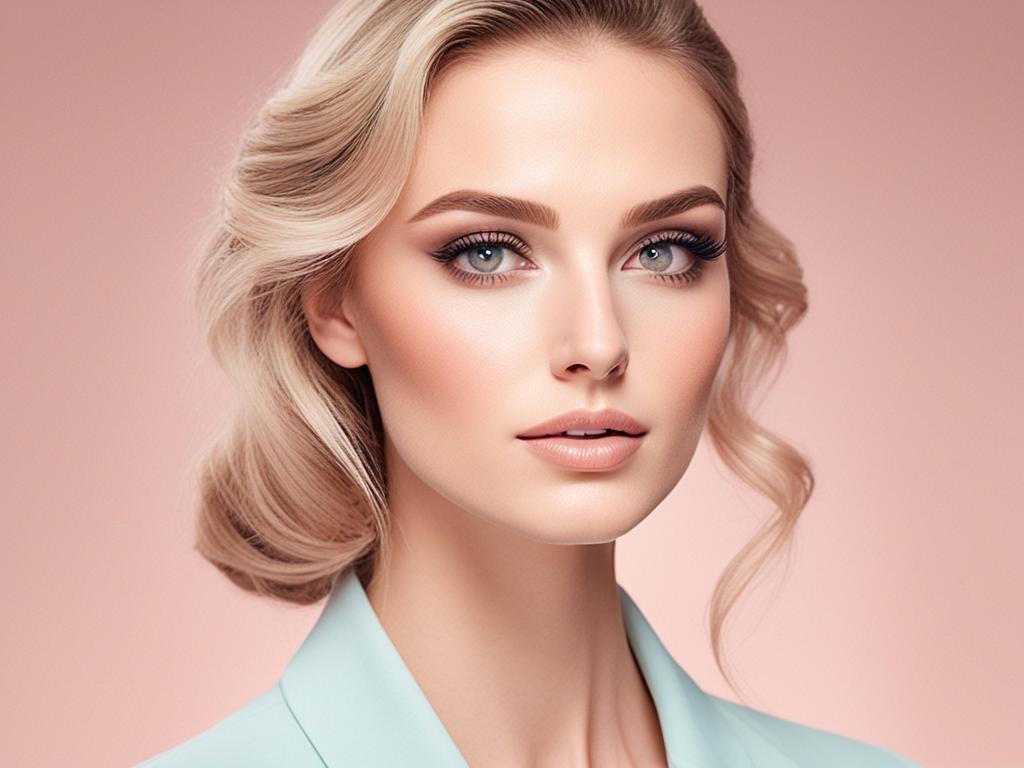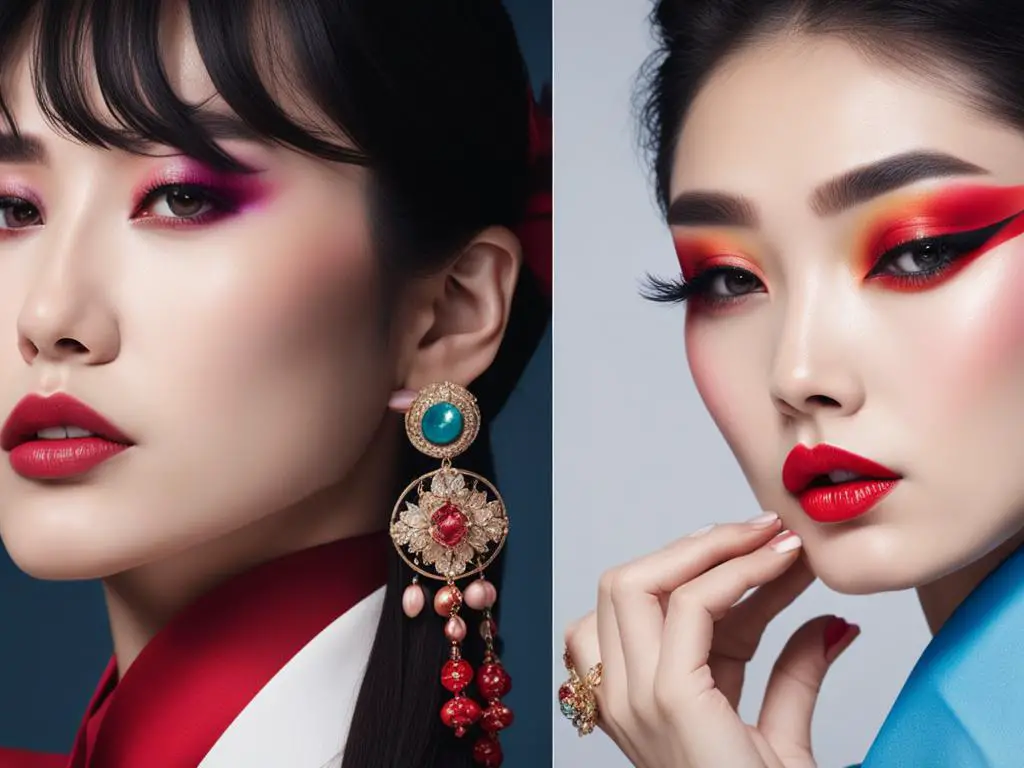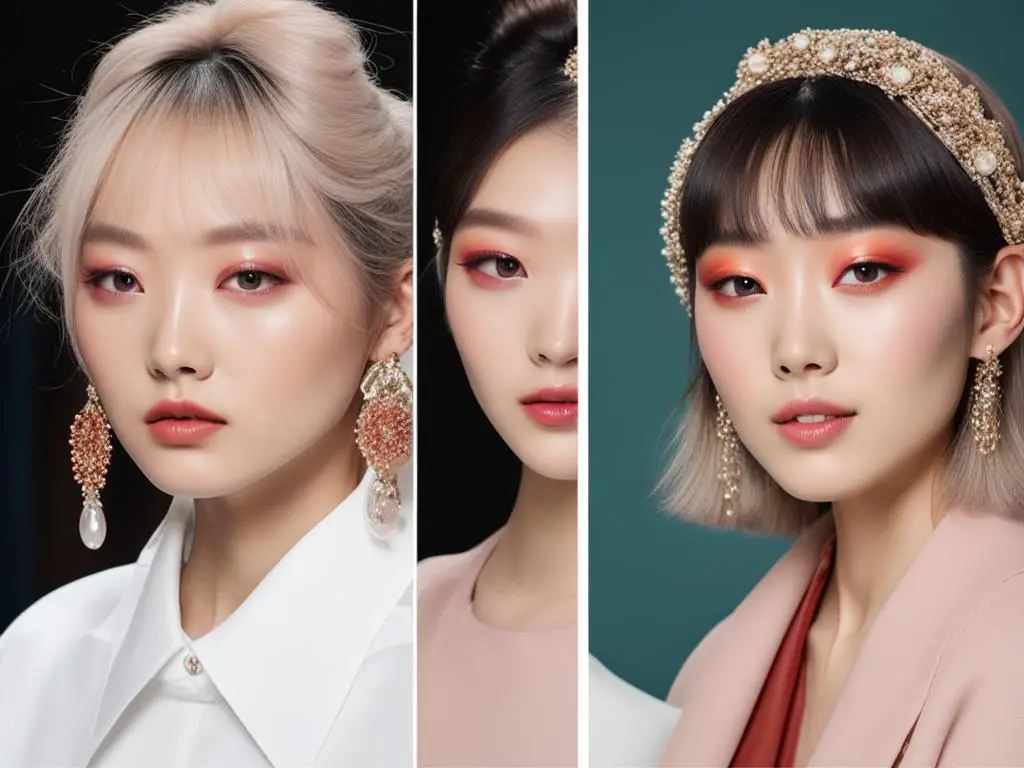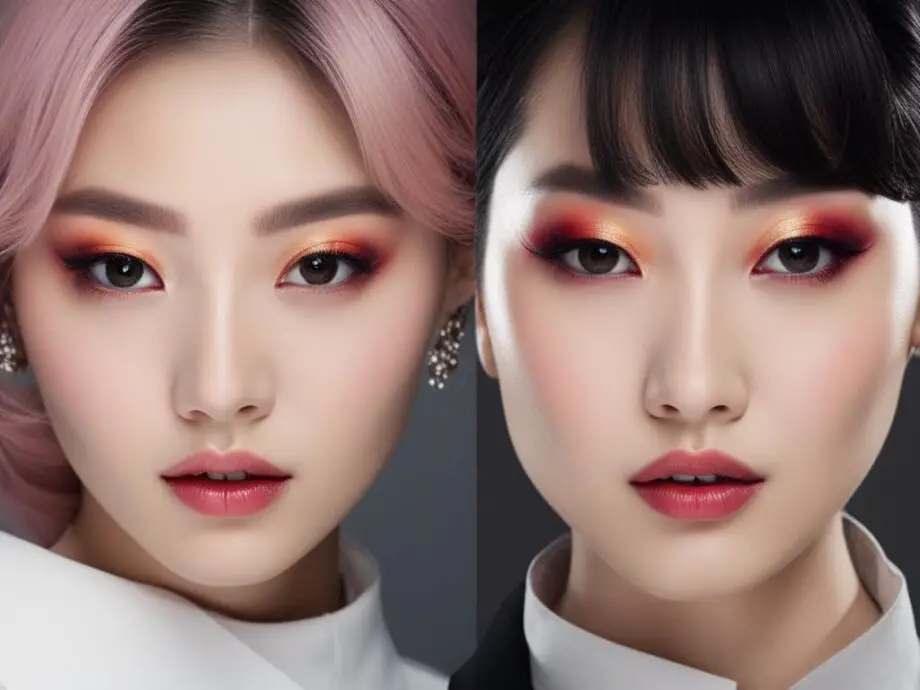When it comes to makeup, there’s an ongoing beauty battle between Japanese and Korean makeup styles. These two distinct aesthetics have captivated beauty enthusiasts around the world, each with its own unique approach to enhancing natural beauty. Exploring the differences and similarities between Japanese and Korean makeup not only sheds light on the rich cultural influences behind these beauty philosophies but also provides insights into the ever-evolving global cosmetics industry.
Asian beauty preferences play a significant role in shaping the cosmetics industry, with Japanese and Korean beauty trends leading the way. From skincare routines to makeup techniques, these two countries have become trendsetters, inspiring international beauty brands and enthusiasts alike. Understanding the nuances of Japanese and Korean makeup allows us to appreciate the artistry and innovation embedded in these beauty cultures.
Key Takeaways:
- Japanese and Korean makeup styles have distinct differences and cultural influences.
- Asian beauty preferences have a significant impact on the global cosmetics industry.
- Understanding the makeup techniques and trends of both countries allows for a deeper appreciation of their unique beauty cultures.
- Japanese and Korean makeup styles inspire and influence international beauty brands and trends worldwide.
- Exploring the beauty battle between Japanese and Korean makeup showcases the enduring appeal of both aesthetics in the modern beauty landscape.
Exploring Japanese Makeup
Japanese makeup is renowned for its unique beauty trends, makeup preferences, and popular styles. Japanese women have long been admired for their impeccable makeup techniques and flawless complexion. Let’s delve into the world of Japanese makeup and discover the secrets behind their captivating beauty.
The Essence of Japanese Makeup
Japanese makeup embraces a minimalist yet sophisticated approach, focusing on enhancing natural features and achieving a youthful, radiant look. The emphasis is on creating a soft, elegant appearance that exudes grace and femininity.
Beauty Trends in Japanese Makeup
Japanese beauty trends are ever-evolving, constantly pushing boundaries and inspiring new styles. From the “no-makeup” look to the iconic “doll-like” aesthetic, Japanese women embrace simplicity, with a touch of whimsy and sophistication.
“Japanese makeup trends are a reflection of the country’s culture and aesthetics. The beauty industry in Japan celebrates subtlety, harmony, and the art of enhancing one’s natural features.”
Popular Styles and Techniques
Japanese makeup is renowned for its meticulous attention to detail and precision. Here are some popular styles and techniques commonly seen:
- Gyaru: A bold and glamorous style characterized by big eyes, dramatic lashes, and vibrant lip colors.
- Natural Makeup: A light and fresh look, emphasizing radiant skin, natural lashes, and soft lip tints.
- Otona Kawaii: The perfect balance between youthful and mature, with subtle blush, soft eyeshadows, and natural lip shades.
- Geisha Makeup: An iconic traditional makeup style featuring striking white foundation, vibrant red lips, and intricately designed eyes.
Must-Have Products in a Japanese Makeup Routine
Japanese women swear by a range of tried-and-true products that are essential for achieving their signature looks. Here are some must-haves in a Japanese makeup routine:
- BB Cream: A lightweight, multi-purpose product that provides sun protection, hydration, and natural coverage.
- Japanese Sunscreen: Known for its high protection against harmful UV rays, these sunscreens are lightweight, non-greasy, and suitable for daily use.
- Mascara: Japanese mascaras are famous for their long-lasting formulas, precise wands, and ability to create voluminous, feathery lashes.
- Lip Tints: Soft, long-lasting lip tints are a staple in Japanese makeup bags, offering a subtle flush of color for a natural look.
Exploring Japanese makeup allows us to appreciate the artistry, versatility, and unique beauty trends that have captivated enthusiasts around the world. In the next section, we will unlock the secrets of Korean makeup and discover how it differs from its Japanese counterpart.
Unveiling Korean Makeup
In the world of cosmetics, Korean makeup has captured the attention of beauty enthusiasts worldwide. With its unique beauty trends, makeup preferences, and popular styles, Korean makeup has become a global phenomenon.

Korean beauty trends are known for their emphasis on achieving flawless, dewy skin and a youthful, natural-looking complexion. The Korean skincare routine, often consisting of multiple steps and products, is a cornerstone of Korean makeup. It focuses on maintaining healthy skin as the foundation for a beautiful makeup application.
One of the most popular makeup techniques in Korean beauty is the “gradient lip,” also known as the “popsicle lip.” This technique involves applying a gradient effect to the lips, with a vibrant color concentrated in the center and gradually blending outward for a soft and youthful appearance.
The Korean “glass skin” trend has also gained significant popularity. This trend aims to achieve a luminous, translucent complexion that mimics the appearance of glass. It typically involves using hydrating skincare products, lightweight foundations, and highlighters to create a radiant glow.
“Korean makeup focuses on enhancing natural features and embracing a youthful, radiant look. It emphasizes skincare as the first step towards achieving flawless makeup.”
The popularity of Korean makeup has also resulted in the rise of innovative products. Cushion compacts, a type of foundation compact with a sponge soaked in liquid foundation, have gained widespread recognition. These compacts provide lightweight coverage and a natural finish, making them a staple in many Korean makeup routines.
Another popular product is the eyebrow pencil, as defined, well-groomed eyebrows are essential in Korean makeup. Korean beauty enthusiasts prefer straighter, softer brows, which are achieved through precise application and gentle strokes.
Popular Korean Makeup Brands
| Brand | Known For |
|---|---|
| Etude House | Playful and youthful makeup |
| Innisfree | Natural and environmentally conscious beauty |
| MISSHA | Affordable and high-quality makeup |
| 3CE | Modern and trendy makeup |
These brands represent just a few examples of the wide range of Korean makeup brands available, each with their own unique style and product offerings.
The influence of Korean makeup can be seen not only in the cosmetics industry but also in the beauty trends embraced by individuals around the world. Its emphasis on natural beauty, skincare, and youthful looks has resonated with people seeking a fresh and radiant appearance.
Next, let’s explore the key differences between Japanese and Korean makeup in the following section.
Differences Between Japanese and Korean Makeup
When it comes to makeup, Japanese and Korean beauty traditions have distinct characteristics that set them apart. These differences not only reflect the unique beauty philosophies and cultural influences of each country but also shape the cosmetic industry in Japan and Korea.
One key difference between Japanese and Korean makeup lies in their beauty preferences. Japanese makeup tends to focus on achieving a natural and subtle look with an emphasis on flawless skin and soft, muted colors. On the other hand, Korean makeup often embraces a more youthful and vibrant aesthetic with a focus on dewy skin, bright colors, and playful accents.
Another area where Japanese and Korean makeup diverge is in their application techniques. Japanese makeup techniques typically prioritize a meticulous approach, with careful attention to detail and precise application. Conversely, Korean makeup techniques often involve layering products and using innovative application methods to achieve a youthful and fresh-faced look.
The cultural influences on Japanese and Korean makeup are also evident in the types of products favored in each country. Japanese makeup places a strong emphasis on skincare, and products like moisturizers, serums, and sheet masks play a crucial role in achieving the desired complexion. In contrast, Korean makeup is known for its BB creams, cushion compacts, and vibrant lip tints that contribute to the much-coveted “glass skin” look.
These differences between Japanese and Korean makeup extend beyond personal preferences and have a significant impact on the cosmetic industry in both countries. Japanese makeup brands often focus on creating high-quality, minimalist products that cater to consumers seeking a refined and sophisticated beauty routine. Meanwhile, Korean makeup brands are renowned for their innovative formulations and playful packaging that appeals to a younger demographic.
Japanese makeup prioritizes a natural and subtle look, while Korean makeup embraces a youthful and vibrant aesthetic.
Japanese makeup techniques emphasize meticulous application, while Korean makeup techniques employ layering and innovative methods.
Japanese makeup brands focus on minimalist products, while Korean makeup brands offer innovative formulations and playful packaging.
Comparison Table: Differences Between Japanese and Korean Makeup
| Aspect | Japanese Makeup | Korean Makeup |
|---|---|---|
| Beauty Preferences | Natural and subtle | Youthful and vibrant |
| Application Techniques | Meticulous and precise | Layering and innovative |
| Product Focus | Skincare and minimalist | Innovative formulations and playful packaging |
As shown in the comparison table above, the differences between Japanese and Korean makeup encompass various aspects, including beauty preferences, application techniques, and product focus. Understanding these distinctions provides valuable insights into the diverse approaches to beauty in Japan and Korea.

Makeup Techniques: Japanese vs Korean
When it comes to makeup techniques, Japanese and Korean beauty cultures showcase their unique approaches to achieving beauty. Japanese makeup techniques emphasize a natural and subtle look that enhances the individual’s features, while Korean makeup techniques often focus on achieving a youthful and vibrant appearance.
In Japanese makeup, the emphasis is on creating a flawless complexion. The goal is to achieve a smooth and even skin tone using lightweight foundations or BB creams. Japanese beauty enthusiasts favor a minimalistic approach, opting for soft and natural colors on the eyes and lips. The emphasis is on enhancing and bringing out the natural beauty without overpowering the facial features.
In contrast, Korean makeup techniques are known for their youthful and radiant looks. The “K-beauty” trend involves achieving glowing skin through the use of skincare products and techniques before applying makeup. Korean women often use multiple layers of hydrating products, such as essences and serums, to create a dewy complexion.
When it comes to eye makeup, Japanese makeup techniques focus on creating subtle and defined eyes. Neutral eyeshadows and thin eyeliners are commonly used to enhance the eyes’ shape and add depth. Korean makeup, on the other hand, often involves a more playful and vibrant approach. Gradient lips, a popular Korean makeup technique, creates a faded color effect, emphasizing a youthful and soft appearance.
To summarize, Japanese makeup techniques lean towards a natural and minimalistic look that enhances the individual’s features, while Korean makeup techniques aim for a youthful and vibrant appearance with a focus on achieving a radiant complexion. These distinct approaches to makeup reflect the beauty preferences and cultural influences within each country.

The Japanese and Korean Makeup Techniques compared:
| Makeup Techniques | Japanese Makeup | Korean Makeup |
|---|---|---|
| Complexion | Focus on achieving a flawless and natural-looking complexion with lightweight foundations or BB creams. | Emphasis on achieving a youthful and radiant complexion through multiple layers of hydrating products and skincare techniques. |
| Eye Makeup | Subtle and defined eyes using neutral eyeshadows and thin eyeliners. | Playful and vibrant eye makeup, often involving the use of gradient eyeshadows and colorful eyeliners. |
| Lips | Natural and soft lip colors that enhance the lips’ natural beauty. | Gradient lips, a popular technique that creates a youthful and soft appearance with a faded color effect. |
Beauty Trends: Japanese vs Korean
When it comes to beauty trends, both Japanese and Korean makeup styles have been making waves in the cosmetic industry. These two Asian beauty cultures have captivated beauty enthusiasts around the world with their unique and innovative approaches to makeup.
Japanese makeup trends are known for their emphasis on natural beauty and subtle elegance. The beauty ideal in Japan revolves around achieving a flawless complexion, with a focus on a luminous, porcelain-like skin tone. Japanese women often opt for light, sheer foundation, paired with soft, pastel shades for their eyes and lips.
Korean makeup trends, on the other hand, lean towards a youthful and radiant look. The Korean beauty industry has popularized the “glass skin” trend, which aims to achieve a dewy, translucent complexion. Korean women often use a combination of skincare products and makeup techniques to achieve this radiant glow. Bold and vibrant colors are also favored in Korean makeup, with gradient lips and defined, straight brows being popular trends.
Japanese and Korean beauty trends both embrace the concept of enhancing natural features, but they differ in their execution. While Japanese makeup focuses on delicacy, Korean makeup embraces a bolder, more youthful aesthetic. These trends constantly evolve and are often influenced by popular culture, fashion, and social media.
Let’s take a closer look at the current popular styles and trends in Japanese and Korean makeup:
Popular Japanese Makeup Trends
- Natural and minimalistic looks
- Pastel shades for eyes and lips
- Soft, subtle blush
- Emphasis on clear and luminous skin
- Bold yet delicate eyelashes
Popular Korean Makeup Trends
- Gradient lips
- Glowing, dewy skin
- Straight, defined eyebrows
- Shimmery and glittery eye makeup
- Subtle contouring techniques
Japanese and Korean makeup trends offer a wide variety of styles for individuals to express their unique beauty. Whether you prefer the natural elegance of Japanese makeup or the youthful radiance of Korean makeup, there is something for everyone in these popular beauty cultures.
By keeping an eye on the latest beauty trends from Japan and Korea, you can incorporate elements of these styles into your own makeup routine, allowing you to stay on top of the ever-changing world of beauty.
| Japanese Makeup | Korean Makeup |
|---|---|
| Natural and minimalistic looks | Gradient lips |
| Pastel shades for eyes and lips | Glowing, dewy skin |
| Soft, subtle blush | Straight, defined eyebrows |
| Emphasis on clear and luminous skin | Shimmery and glittery eye makeup |
| Bold yet delicate eyelashes | Subtle contouring techniques |
As we can see, there are distinct differences in the popular trends between Japanese and Korean makeup. Japanese makeup leans towards a more natural and understated look, while Korean makeup embraces a youthful and radiant aesthetic.
Ultimately, the choice between Japanese and Korean makeup styles is a matter of personal preference. Whether you prefer the elegance of Japanese beauty trends or the youthful energy of Korean trends, experimenting with these styles can expand your beauty repertoire and help you discover new ways to enhance your natural features.
Influence of Japanese and Korean Makeup on the Global Cosmetics Industry
Japanese and Korean makeup have significantly influenced the global cosmetics industry, shaping beauty trends and inspiring international brands. The unique beauty cultures of Japan and Korea have captured the attention of beauty enthusiasts worldwide, leading to the global popularity of their distinctive makeup styles.
Japanese makeup, known for its emphasis on natural beauty and subtle elegance, has had a profound impact on the cosmetics industry. The Japanese beauty trend of “Illuminating Skin” focuses on achieving a radiant, dewy complexion through skincare and light, minimalistic makeup. This emphasis on skincare as the foundation of makeup has influenced beauty brands globally, leading to the rise of lightweight, nourishing foundations, and skincare-infused cosmetics.
Korean makeup, on the other hand, is celebrated for its youthful and vibrant looks. The popular K-beauty trend of “Glass Skin” aims to achieve a flawless, luminous complexion with a smooth texture. Korean makeup techniques, such as the “Gradient Lip” and “Puppy Eyes,” have gained international recognition and have been adopted by numerous beauty brands worldwide. The influence of Korean makeup can be seen in the widespread use of cushion foundations, vibrant lip tints, and innovative eye makeup products.
“The focus on skincare as the basis of makeup has become a global phenomenon, thanks to the influence of Japanese and Korean beauty cultures.”
Japanese and Korean beauty trends continue to dictate the direction of the global cosmetics industry. Their commitment to innovation, quality, and unique aesthetics resonates with consumers seeking efficient skincare routines and creative makeup looks. The influence of Japanese and Korean makeup can be observed in the formulation of products, packaging designs, and marketing strategies adopted by international beauty brands.
The Impact of Influencers and Social Media
In recent years, social media platforms have played a crucial role in propagating Japanese and Korean makeup trends across the globe. Influencers and beauty content creators from Japan and Korea have amassed a massive following, promoting and showcasing their country’s beauty products and techniques.
Through platforms like Instagram, YouTube, and TikTok, these influencers have been pivotal in popularizing Japanese and Korean makeup trends among an international audience. Their endorsement of specific products and demonstration of unique techniques have led to a surge in the demand for Japanese and Korean beauty products worldwide.
The Continued Growth of the Asian Beauty Market
The overwhelming success of Japanese and Korean makeup and skincare has contributed to the growth of the Asian beauty market. With consumers increasingly fascinated by Asian beauty trends, the demand for Japanese and Korean cosmetics has expanded beyond the borders of their home countries.
The global recognition of Japanese and Korean beauty brands, such as Shiseido, SK-II, Etude House, and Laneige, has played a significant role in shaping the cosmetics industry. These brands have capitalized on their rich heritage, innovative formulas, and dedication to skincare, becoming household names and inspiring countless beauty brands worldwide.
The influence of Japanese and Korean makeup on the global cosmetics industry is undeniable. From skincare-focused routines to vibrant makeup looks, the distinctive beauty cultures of Japan and Korea have left an indelible mark on the beauty world, inspiring countless beauty enthusiasts and shaping the direction of the industry as a whole.
| Japanese Makeup | Korean Makeup |
|---|---|
| Focus on natural beauty | Emphasis on youthful and vibrant looks |
| Illuminating Skin: Achieving a radiant, dewy complexion | Glass Skin: Striving for flawless and luminous skin |
| “Illuminating Skin” inspired lightweight, nourishing foundations | “Glass Skin” led to the popularity of cushion foundations |
| Minimalistic makeup emphasizing skincare | Creative and innovative eye, lip, and face makeup |
Conclusion
In this article, we explored the beauty battle between Japanese makeup and Korean makeup, two distinct styles that have captivated the beauty industry. Both Japanese and Korean makeup have their unique characteristics, reflecting the cultural influences and beauty philosophies of each country. Japanese makeup is known for its subtle and natural approach, while Korean makeup embraces a more youthful and vibrant aesthetic.
Throughout the article, we discussed the differences in makeup techniques and beauty trends, highlighting how Japanese and Korean makeup have inspired and influenced global beauty preferences. Japanese makeup leans towards enhancing natural features, focusing on flawless skin and soft, understated colors. On the other hand, Korean makeup embraces a youthful glow, incorporating playful and innovative techniques, such as gradient lips and aegyo-sal.
The ongoing beauty battle between Japanese and Korean makeup demonstrates the enduring appeal of these styles. Their popularity has spread beyond Asia’s borders, with international beauty brands and enthusiasts seeking inspiration from these iconic beauty cultures. The impact of Asian beauty products on the global cosmetics industry cannot be overstated, as they continue to shape and redefine beauty trends on a worldwide scale.
In conclusion, the beauty battle between Japanese and Korean makeup is a testament to the diverse and evolving nature of beauty preferences. From the natural elegance of Japanese makeup to the youthful exuberance of Korean makeup, both styles offer a plethora of techniques and trends for beauty enthusiasts to explore. Whether you’re drawn to the timeless allure of Japanese makeup or the innovative charm of Korean makeup, each has its own unique beauty to offer.
FAQ
What is Japanese makeup?
Japanese makeup refers to the beauty trends, techniques, and products commonly used by Japanese women. It often focuses on achieving a natural and delicate look, with an emphasis on flawless skin, soft colors, and understated elegance.
What is Korean makeup?
Korean makeup refers to the beauty trends, techniques, and products commonly used by Korean women. It often emphasizes a youthful and vibrant appearance, with a focus on dewy skin, bright colors, and playful accents like gradient lips and straight brows.
What are the main differences between Japanese and Korean makeup?
The main differences lie in the overall aesthetic preferences and techniques used. Japanese makeup tends to focus on a more minimalistic and natural look, while Korean makeup leans towards a youthful and energetic style. The color choices, application methods, and emphasis on specific features also differ between the two.
What are some popular makeup techniques in Japanese and Korean makeup?
Japanese makeup often involves using light foundation for a more translucent appearance, accentuating the eyes with mascara and eyeliner, and using soft blush to add a natural flush. On the other hand, Korean makeup commonly incorporates techniques like the use of cushion foundations, gradient lips, and straight, defined brows.
What are the current beauty trends in Japanese and Korean makeup?
Some popular beauty trends in Japanese makeup include the use of “me no shita chiiku” or “under-eye blush” to create a youthful flush, as well as “byojaku makeup” to accentuate the eyes. In Korean makeup, trends like “glass skin” (dewy, luminous complexion) and “puppy eyes” (upturned eyes) are currently popular.
How has Japanese and Korean makeup influenced the global cosmetics industry?
Japanese and Korean makeup have had a significant impact on the global cosmetics industry. The innovative products, unique techniques, and trendsetting styles from both countries have inspired international beauty brands to create their own versions. Korean skincare routines and Japanese beauty rituals have also become popular worldwide.
What can we conclude about the beauty battle between Japanese and Korean makeup?
The beauty battle between Japanese and Korean makeup continues to captivate beauty enthusiasts around the world. The distinct styles, techniques, and preferences in both cultures offer a diverse range of inspirations. Ultimately, it is the celebration of individuality and the endless possibilities of self-expression that make both Japanese and Korean makeup styles so appealing.
